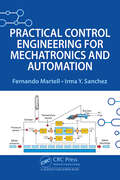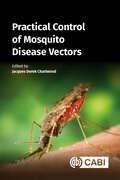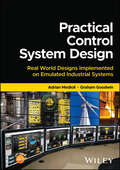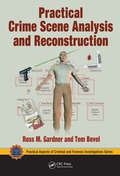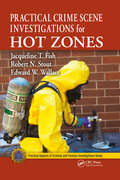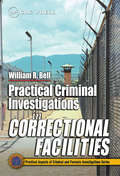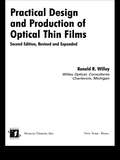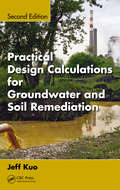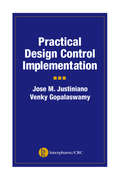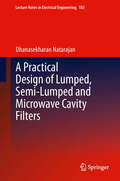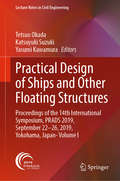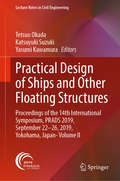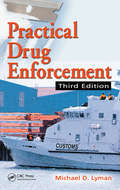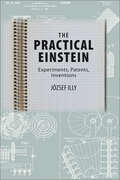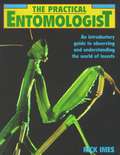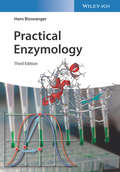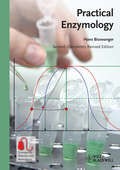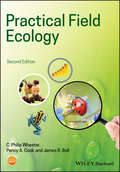- Table View
- List View
Practical Control Engineering for Mechatronics and Automation
by Fernando Martell Irma Y. SanchezProduction processes and engineered systems use continuous and discrete variables, as well as the combination of continuous and sequential operations. This volume covers both aspects, thus providing knowledge in continuous and discrete control, logic control, and hybrid control systems. It is a compilation of selected control strategies to automate processes and systems with a practical approach to ease their design, analysis and implementation. The selection of the control schemes is based on the capability to provide desired dynamical response or real time performance. Practicality is required for achieving faster development times of automation projects or system prototypes by comprehensive presentation and direct application of methodologies and techniques for efficient and structured programming of control algorithms. Considered methodologies include model-based design, hardware in the loop simulations and structured programming. Fundamental signals and systems concepts are explained. Systems and controllers are analyzed using discrete-time equations, which ease their implementation in most programmable platforms without requiring sophisticated software. PID based control, internal model control and model reference control are viewed as powerful schemes in terms of performance and suitability for mechatronics systems because of the use of the model in their architecture as a key control element. Finite state machines are presented to solve sequential requirements of direct and supervisory control of many processes and machines. Cyberphysical systems are an industrial technology and an education trend, distinguished by visual and dynamic models or digital twins of the physical systems. The discussed analysis, design and implementation practices are integrated and applied in the context of cyberphysical systems. This book aims to provide multidisciplinary support to engineers and practitioners in the design of control systems, and is a valuable tool for automation teaching and self-learning.
Practical Control of Mosquito Disease Vectors
by Jacques Derek CharlwoodDisease vector control is rapidly changing, both because of the emergence of resistance to conventional methods and the development of new and potentially game-changing techniques. This book reviews several current and future measures for controlling mosquito vectors of disease, with an emphasis on malaria vectors. Beginning with an introduction to the topic of mosquito ecology and sampling methods, the book then covers several vector-borne disease control methods. The emphasis in many of these methods is for the sufferers of the diseases to take charge of their monitoring and control. Tackling the problems facing mosquito control, the authors review the important issues of education, economic considerations and climate change before concluding with a consideration of the politics and practicalities of method choice and implementation. This book is a thought-provoking concise and practical resource for anyone interested in primary healthcare and tackling or studying mosquito disease vectors.
Practical Control System Design: Real World Designs Implemented on Emulated Industrial Systems
by Adrian Medioli Graham GoodwinPractical Control System Design This book delivers real world experience covering full-scale industrial control design, for students and professional control engineers Inspired by the authors’ industrial experience in control, Practical Control System Design: Real World Designs Implemented on Emulated Industrial Systems captures that experience, along with the necessary background theory, to enable readers to acquire the tools and skills necessary to tackle real world control engineering design problems. The book draws upon many industrial projects conducted by the authors and associates; these projects are used as case studies throughout the book, organized in the form of Virtual Laboratories so that readers can explore the studies at their own pace and to their own level of interest. The real-world designs include electromechanical servo systems, fluid storage, continuous steel casting, rolling mill center line gauge control, rocket dynamics and control, cross directional control in paper machines, audio quantisation, wind power generation (including 3 phase induction machines), and boiler control. To facilitate reader comprehension, the text is accompanied by software to access the individual experiments. A full Solutions Manual for the questions set in the text is available to instructors and practicing engineers. Background theory covered in the text includes control as an inverse problem, impact of disturbances and measurement noise, sensitivity functions, Laplace transforms, Z-Transforms, shift and delta operators, stability, PID design, time delay systems, periodic disturbances, Bode sensitivity trade-offs, state space models, linear quadratic regulators, Kalman filters, multivariable systems, anti-wind up strategies, Euler angles, rotational dynamics, conservation of mass, momentum and energy as well as control of non-linear systems. Practical Control System Design: Real World Designs Implemented on Emulated Industrial Systems is a highly practical reference on the subject, making it an ideal resource for undergraduate and graduate students on a range of control system design courses. The text also serves as an excellent refresher resource for engineers and practitioners.
Practical Controls: A Guide To Mechanical Systems
by Steven R. CalabreseGeared toward the HVAC professional, Practical Controls: A Guide to Mechanical Systems provides a solid foundation and well-rounded understanding of the role of controls in mechanical systems design and installation. This book takes a concise look at HVAC controls and controls methods - including electrical, electronic, and microprocessor-based controls and control systems. Using "real world" examples, it explores how various mechanical systems installed in today's facilities are best controlled. The text is a practical resource to controls contracting, providing basic rules, equipment guidelines, rules of thumb, pros and cons, and do's and don'ts.
Practical Crime Scene Analysis and Reconstruction (ISSN)
by Ross M. Gardner Tom BevelThis book addresses every aspect of the analysis and reconstruction of the events surrounding a crime. Beginning with established protocols for crime scene processing, the authors outline their unique methodology for event analysis. This technique defines specific actions, discusses the order of those actions, and offers significant insight into determining what did or did not happen in the course of the incident under investigation. Using case studies and more than 200 color photos, the book demonstrates how the method can be used to explain clues that would otherwise be puzzling or ambiguous.
Practical Crime Scene Investigations for Hot Zones (ISSN)
by Jacqueline T. Fish Robert N. Stout Edward WallaceThe work of crime scene investigators (CSIs) is made more complicated when the scene is contaminated by either chemical, biological, radiological, nuclear, explosives (CBRNE) or toxic industrial chemicals (TICs). Special considerations must be observed when working at such scenes, whether they are the result of acts of terrorism, accidents, or natural disasters. This volume is a comprehensive reference containing guidelines and best practices for keeping CSIs safe and conducting a thorough crime scene investigation in these deadly environments. Protocols are provided for how to best identify, document, collect, and preserve physical evidence.
Practical Crime Scene Processing and Investigation (Practical Aspects of Criminal and Forensic Investigations)
by Ross M. Gardner Donna Krouskup<p>Every action performed by a crime scene investigator has an underlying purpose: to both recover evidence and capture scene context. It is imperative that crime scene investigators must understand their mandate—not only as an essential function of their job but because they have the immense responsibility and duty to do so. <p>Practice Crime Scene Processing and Investigation, Third Edition provides the essential tools for what crime scene investigators need to know, what they need to do, and how to do it. As professionals, any investigator’s master is the truth and only the truth. Professional ethics demands an absolute adherence to this mandate. When investigators can effectively seek, collect, and preserve information and evidence from the crime scene to the justice system—doing so without any agenda beyond seeking the truth— not only are they carrying out the essential function and duty of their job, it also increases the likelihood that the ultimate goal of true justice will be served. <p>Richly illustrated—with more than 415 figures, including over 300 color photographs—the Third Edition of this best-seller thoroughly addresses the role of the crime scene investigator in the context of: <p> <i>Understanding the nature of physical evidence, including fingerprint, biological, trace, hair and fiber, impression, and other forms of evidence <i>Assessing the scene, including search considerations and dealing with chemical and bioterror hazards <i>Crime scene photography; scene sketching, mapping, and documentation; and the role of crime scene analysis and reconstruction <i>Bloodstain pattern analysis and discussion of the body as a crime scene <i>Special scene considerations, including fire, buried bodies, and entomological evidence <i>Coverage details the importance of maintaining objectivity, emphasizing that every action the crime scene investigator performs has an underlying purpose: to both recover evidence and capture scene context.</i> </p>
Practical Criminal Investigations in Correctional Facilities (ISSN)
by William R. BellAN INSIDE LOOK INTO INVESTIGATING THE MOST VIOLENT SUB-CULTURE IN THE WORLDOnce an offender is behind bars, many people believe that he is no longer a threat to society. However, the felonious activities of confined inmates reach out into society every day. These inmates run lucrative drug operations, commit fraud, hire contract murders, an
Practical Design and Production of Optical Thin Films (Optical Engineering Ser. #Vol. 56)
by Ronald R. WilleyProviding insider viewpoints and perspectives unavailable in any other text, this book presents useful guidelines and tools to produce effective coatings and films. Covering subjects ranging from materials selection and process development to successful system construction and optimization, it contains expanded discussions on design visualization, dense wavelength division multiplexing, new coating equipment, electrochromic and chemically active coatings, ion-assisted deposition, and optical monitoring sensitivity. Furnishing real-world examples and know-how, the book introduces Fourier analysis and synthesis without difficult mathematical concepts and equations.
Practical Design Calculations for Groundwater and Soil Remediation
by Jeff KuoIncludes Illustrative Applications of Practical Design CalculationsWritten in a straightforward style and user-friendly format, Practical Design Calculations for Groundwater and Soil Remediation, Second Edition highlights the essential concepts and important aspects of major design calculations used in soil and groundwater remediation. Drawi
Practical Design Control Implementation for Medical Devices
by Jose Justiniano Venky GopalaswamyBringing together the concepts of design control and reliability engineering, this book is a must for medical device manufacturers. It helps them meet the challenge of designing and developing products that meet or exceed customer expectations and also meet regulatory requirements. Part One covers motivation for design control and validation, desig
A Practical Design of Lumped, Semi-lumped & Microwave Cavity Filters (Lecture Notes in Electrical Engineering #183)
by Dhanasekharan NatarajanThis book presents the application of microwave literature for designing lumped/semi-lumped filters and combline/iris-coupled microwave cavity filters. It provides the physical understanding of the terms and characteristics of radio frequency (RF) filters. The book complements engineering text books on RF components and provides support for the project assignments of students. In addition to the functional design of RF filters, the integrated design approach for produceability and reliability is explained.
Practical Design of Magnetostatic Structure Using Numerical Simulation
by Qiuliang WangMagnets are widely used in industry, medical, scientific instruments, and electrical equipment. They are the basic tools for scientific research and electromagnetic devices. Numerical methods for the magnetic field analysis combined with mathematical optimization from practical applications of the magnets have been widely studied in recent years. It is necessary for professional researchers, engineers, and students to study these numerical methods for the complex magnet structure design instead of using traditional "trial-and-error" methods. Those working in this field will find this book useful as a reference to help reduce costs and obtain good magnetic field quality. Presents a clear introduction to magnet technology, followed by basic theories, numerical analysis, and practical applications Emphasizes the latest developments in magnet design, including MRI systems Provides comprehensive numerical techniques that provide solutions to practical problems Introduces the latest computation techniques for optimizing and characterizing the magnetostatic structure design Well organized and adaptable by researchers, engineers, lecturers, and students Appendix available on the Wiley Companion Website As a comprehensive treatment of the topic, Practical Design of Magnetostatic Structure Using Numerical Simulation is ideal for researchers in the field of magnets and their applications, materials scientists, structural engineers, and graduate students in electrical engineering. The book will also better equip mechanical engineers and aerospace engineers.
Practical Design of Ships and Other Floating Structures: Proceedings of the 14th International Symposium, PRADS 2019, September 22-26, 2019, Yokohama, Japan- Volume III (Lecture Notes in Civil Engineering #65)
by Tetsuo Okada Katsuyuki Suzuki Yasumi KawamuraThis book gathers the peer-reviewed proceedings of the 14th International Symposium, PRADS 2019, held in Yokohama, Japan, in September 2019. It brings together naval architects, engineers, academic researchers and professionals who are involved in ships and other floating structures to share the latest research advances in the field. The contents cover a broad range of topics, including design synthesis for ships and floating systems, production, hydrodynamics, and structures and materials. Reflecting the latest advances, the book will be of interest to researchers and practitioners alike.
Practical Design of Ships and Other Floating Structures: Proceedings of the 14th International Symposium, PRADS 2019, September 22-26, 2019, Yokohama, Japan- Volume I (Lecture Notes In Civil Engineering Ser. #65)
by Tetsuo Okada Katsuyuki Suzuki Yasumi KawamuraThis book gathers the peer-reviewed proceedings of the 14th International Symposium, PRADS 2019, held in Yokohama, Japan, in September 2019. It brings together naval architects, engineers, academic researchers and professionals who are involved in ships and other floating structures to share the latest research advances in the field. The contents cover a broad range of topics, including design synthesis for ships and floating systems, production, hydrodynamics, and structures and materials. Reflecting the latest advances, the book will be of interest to researchers and practitioners alike.
Practical Design of Ships and Other Floating Structures: Proceedings of the 14th International Symposium, PRADS 2019, September 22-26, 2019, Yokohama, Japan- Volume II (Lecture Notes in Civil Engineering #64)
by Tetsuo Okada Katsuyuki Suzuki Yasumi KawamuraThis book gathers the peer-reviewed proceedings of the 14th International Symposium, PRADS 2019, held in Yokohama, Japan, in September 2019. It brings together naval architects, engineers, academic researchers and professionals who are involved in ships and other floating structures to share the latest research advances in the field. The contents cover a broad range of topics, including design synthesis for ships and floating systems, production, hydrodynamics, and structures and materials. Reflecting the latest advances, the book will be of interest to researchers and practitioners alike.
Practical Drug Enforcement (ISSN)
by Michael D. LymanCriminal investigation is a dynamic endeavor impacted by changes in human nature, statutory and constitutional laws, and methods of operation. New challenges are constantly posed for the investigator and the investigation of drug offenses is no exception. It takes advanced skills to keep pace with the criminal mind. Unfortunately, the skills acquir
The Practical Einstein: Experiments, Patents, Inventions
by József Illy2012 Outstanding Academic Title, Choice MagazineAlbert Einstein may be best known as the wire-haired whacky physicist who gave us the theory of relativity, but that’s just one facet of this genius’s contribution to human knowledge and modern science. As József Illy expertly shows in this book, Einstein had an eminently practical side as well.As a youth, Einstein was an inveterate tinkerer in the electrical supply factory his father and uncle owned and operated. His first paid job was as a patent examiner. Later in life, Einstein contributed to many inventions, including refrigerators, microphones, and instruments for aviation. In published papers, Einstein often provided ways to test his theories and fundamental problems of the scientific community of his times. He delved deeply into a variety of technological innovations, most notably the gyrocompass, and consulted for industry in patent cases and on other legal matters. Einstein also provided explanations for common and mundane phenomena, such as the meandering of rivers. In these and other hands-on examples culled from the Einstein Papers, Illy demonstrates how Einstein enjoyed leaving the abstract world of theories to wrestle with the problems of everyday life.While we may like the idea of Einstein as a genius besotted by extra dimensions and too out-of-this-world to wear socks, The Practical Einstein gives ample evidence that this characterization is both incomplete and an unfair representation of a man who sought to explore the intricacies of nature, whether in theory or in practice.
The Practical Einstein: Experiments, Patents, Inventions
by József IllyThis unique biography of the famous theoretical physicist explores his work in the practical worlds of technology, engineering and experimental physics.Albert Einstein is known as the whacky genius behind the theory of relativity, but that’s just one facet of his contribution to modern science and human knowledge. As József Illy demonstrates in this book, Einstein had an eminently practical side as well.As a youth, Einstein was an inveterate tinkerer in the electrical supply factory owned by his father and uncle. His first paid job was as a patent examiner. He consulted on industrial patent cases and worked on technological innovations, most notably the gyrocompass. Later in life, Einstein contributed to many inventions, including refrigerators, microphones, and instruments for aviation. His published papers often provided ways to test his theories, and he also wrote explanations for common natural phenomena, such as the meandering of rivers.In these and other hands-on examples culled from the Einstein Papers, Illy demonstrates how Einstein enjoyed leaving the abstract world of theories to wrestle with the problems of everyday life.A Choice Magazine Outstanding Academic Title
Practical Electronics For Inventors, Fourth Edition
by Simon Monk Paul ScherzA Fully Updated, No Nonsense Guide to Electronics Advance your electronics knowledge and gain the skills necessary to develop and construct your own functioning gadgets. Written by a pair of experienced engineers and dedicated hobbyists, Practical Electronics for Inventors, Fourth Edition, lays out the essentials and provides step by step instructions, schematics, and illustrations. Discover how to select the right components, design and build circuits, use microcontrollers and ICs, work with the latest software tools, and test and tweak your creations. This easy to follow book features new instruction on programmable logic, semiconductors, operational amplifiers, voltage regulators, power supplies, digital electronics, and more.
The Practical Entomologist
by Rick Imes<p>From exploring the basic principles of entomology to starting a collection, The Practical Entomologist is the perfect introduction to the world of insects. <p>Beginning with the basics, the text describes what characterizes an insect, including anatomy and the life cycle. It takes an order-by-order look at insects, explaining how each group differs from another and why certain types of insects have been classified together. The book shows you not only what to look for but how and where to look for it -- from capturing and keeping live insects to ways of making a collection and taking photographs. <p>Tips on keeping a field notebook are also included. Packed with more than 200 full-color illustrations, this comprehensive guide is a valuable reference tool for nature enthusiasts.</p>
Practical Environmental Bioremediation: The Field Guide, Second Edition
by R. Barry King John K. Sheldon Gilbert M. LongBioremediation, or enhanced microbiological treatment, of environments contaminated with a variety of organic and inorganic compounds is one of the most effective innovative technologies to come around this century! Practical Environmental Bioremediation: The Field Guide presents updated material, case histories and many instructive illustrations to reflect the evolving image of this fast-emerging industry. Bioremediation technology has witnessed great strides towards simplifying treatability formats, finding new approaches to field application, more potent nutrient formulations, monitoring protocols and the resulting general improvement in results. This new guide condenses all current available knowledge and presents necessary technical aspects and concepts in language that can be readily comprehended by the technical student, experienced scientist or engineer, the aspiring newcomer, or anyone else interested in this exciting natural cleanup technique.
Practical Enzymology
by Hans BisswangerA practice-oriented guide to assaying more than 100 of the most important enzymes, complete with the theoretical background and specific protocols for immediate use in the biochemical laboratory. Now expanded with a new section on metal ion determination.
Practical Enzymology
by Hans BisswangerThe second edition of the perfect companion for practical course work in enzymology. Now with an improved selection of enzymatic assays based on key metabolic reactions, this book provides the detailed background to the enzymatic reaction and the enzyme per se. Particular emphasis is placed on troubleshooting with the described methods, and, in addition, the new four-color layout throughout features detailed protocols highlighted for easy recognition. www.wiley-vch.de/home/enzymology: A companion website provides animations for all figures together with supplementary material, for deeper understanding of the partially abstract matter.
Practical Field Ecology: A Project Guide
by C. Philip Wheater James R. Bell Penny A. CookOffers a comprehensive, accessible introduction to experimental design, field monitoring skills for plants and animals, data analysis, interpretation and reporting This user-friendly book presents field monitoring skills for both plants and animals, within the context of a research project. This text provides a single resource to take the reader all the way through from the planning stage, into the field, guiding through sampling, organism identification, computer-based data analysis and interpretation, and finally how to present the results to maximise the impact of the work. Logically structured throughout, and revised extensively in the second edition, the book concentrates on the techniques required to design a field-based ecological survey and shows how to execute an appropriate sampling regime. It evaluates appropriate sampling and analytical methods, identifying potential problems associated with various techniques and how to mitigate these. The second edition of this popular text has updated reference material and weblinks, increased the number of case studies by 50% to illustrate the use of specific techniques in the field, added over 20% more figures (including 8 colour plates), and made more extensive use of footnotes to provide extra details. Extensions to topics covered in the first edition include additional discussion of: ethical issues; statistical methods (sample size estimation, use of the statistical package R, mixed models); bioindicators, especially for freshwater pollution; seeds, fecundity and population dynamics including static and dynamic life tables; forestry techniques including tree coring and tree mortality calculations; the use of data repositories; writing for a journal and producing poster and oral presentations. In addition, the use of new and emerging technologies has been a particular focus, including mobile apps for environmental monitoring and identification; land cover and GIS; the use of drones including legal frameworks and codes of practice; molecular field techniques including DNA analysis in the field (including eDNA); photo-matching for identifying individuals; camera trapping; modern techniques for detecting and analysing bat echolocation calls; and data storage using the cloud. Divided into six distinct chapters, Practical Field Ecology, 2nd Edition begins at project inception with a chapter on planning—covering health and safety, along with guidance on how to ensure that the sampling and experimental design is suitable for subsequent statistical analysis. Following a chapter dealing with site characterisation and general aspects of species identification, subsequent chapters describe the techniques used to survey and census particular groups of organisms. The final chapters cover analysing, interpreting and presenting data, and writing up the research. Offers a readable and approachable integrated guide devoted to field-based research projects Takes students from the planning stage, into the field, and clearly guides them through organism identification in the laboratory and computer-based data analysis, interpretation and data presentation Includes a chapter on how to write project reports and present findings in a variety of formats to differing audiences Aimed at undergraduates taking courses in Ecology, Biology, Geography, and Environmental Science, Practical Field Ecology, 2nd Edition will also benefit postgraduates seeking to support their projects.
